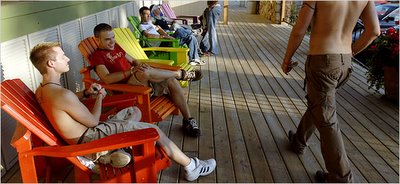 The scene on the deck at the Dunes Resort in Douglas, Mich. The number of gay-owned businesses in this Lake Michigan area has more than tripled in four years.
The scene on the deck at the Dunes Resort in Douglas, Mich. The number of gay-owned businesses in this Lake Michigan area has more than tripled in four years.The New York Times tells you where to go!
ED GREEN stood inside his gift shop on Center Street in Douglas, Mich., squinting through the glass storefront and pointing quickly left and right. “The new flower shop — gay,” he said. “The new gallery across the street, that shop there, the gallery near the pizza place — all gay.”
Mr. Green, who has owned the shop, called Thomas Greene, with his life and business partner, John Thomas, for 15 years, was illustrating the gay evolution of this tiny village. Though nearby Saugatuck, another Lake Michigan beach town, gets national attention for being a gay getaway — it’s known as the Fire Island of the Midwest — it’s tiny Douglas, population 1,200, that has really come out lately.
“There’s been a real renaissance,” Mr. Green said. “We still have people who have been coming to the area for 20 years who make their way over here and are like, ‘Wow, I had no idea!’ It’s really still being discovered.”
When it comes to emerging gay vacation towns, Douglas is not alone. Sure, gay men and lesbians can vacation openly almost anywhere these days. But that cultural shift hasn’t meant the dissolution of traditional gay-getaway enclaves — small towns equipped with gay-owned bed-and-breakfasts, a nightclub or two, relaxing settings like beaches or mountains and a rainbow-clad reputation.
Such places are thriving, and, like Douglas, growing, in unexpected locations all across the country.
And there are “Fire Islands” in just about every region of the States, from Maine and North Carolina to Puna, Hawaii, and upstate New York.
“The big gay Meccas used to be Provincetown, Palm Springs and Southern Florida, period,” said Scott Coatsworth, who has operated an online guide to gay-owned inns, PurpleRoofs.com, since 1998. “Over the last few years, though, we’ve seen several other up-and-coming destinations develop — most notably Ogunquit in Maine, the Saugatuck area in Michigan, Eureka Springs in Arkansas, and Guerneville, Calif. Many of these places have historically been gay friendly, but they’ve become more widely known in the last few years, in large part because of the Internet.”
The Internet has certainly been a factor in getting the word out. But many of the more legendary destinations, like Key West and Provincetown, drew gay people organically through deep connections with artists, writers, actors and other bohemian types. For other places — like Delaware’s way-gay Rehoboth Beach; the Russian River region (around Guerneville) of Northern California; Asbury Park, N.J., and nearby Ocean Grove; and Fort Lauderdale, Fla. — a convergence of factors has been involved: proximity to a major city, natural beauty and an affordable housing stock with great aesthetic potential.
But at its root, the evolution of gay vacation communities has been a simple word-of-mouth phenomenon, bringing large numbers of visitors, home buyers and innkeepers who, in turn, bring more.
Keep Reading:NewYorkTimes
No comments:
Post a Comment